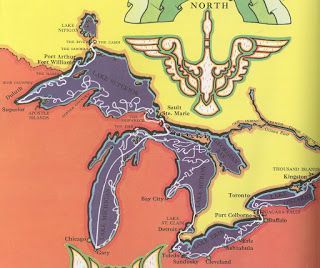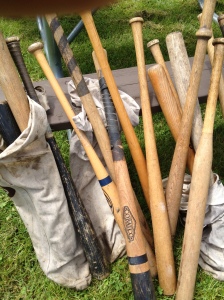When I was growing up on the farm that a century earlier had been the McEachron homestead, walking to the creek was always an adventure. Alone, or with a friend or sibling, I explored the twists and turns as the creek wound through the cottonwoods and marshlands. Treasured finds were the big rock, perfect for picnicking; the glen carpeted with with white and purple violets, a muskrat swiftly swimming by, and pheasants that we startled into flight.
It was some time before I realized that, like Paddle to the Sea, (we watched the movie, based on Holling C. Holling’s book, every year at Yorkville School), I could follow this creek all the way to the ocean. Yes, the creek fed into the Root River, which poured into Lake Michigan, and from there one could get to the Atlantic Ocean and then anywhere in the world. I imagined where it might take me, though I never followed very far in reality. Still I knew where it passed Observatory Hill, and where a branch went south to cross the Plank Road.
way to the ocean. Yes, the creek fed into the Root River, which poured into Lake Michigan, and from there one could get to the Atlantic Ocean and then anywhere in the world. I imagined where it might take me, though I never followed very far in reality. Still I knew where it passed Observatory Hill, and where a branch went south to cross the Plank Road.
The Racine County Highway Department will be removing the large culvert currently at that spot on the Plank Road and replacing it with a bridge this fall. Careful readers of Plank Road Summer, as they cross that bridge, will be able to recall that in our book, a step in an important journey takes place at that site–a journey to a new life.
As for my life, and Hilda’s as well, our later years took us to Racine Lutheran High School, where that same creek, now the Root River, twisted right around us. Gym classes and track practice had me jogging across the river’s bridge many a time. And it was in the embrace of the river, at Lutheran High, that my first opportunity to cross the Atlantic came, when I took a German class trip to Germany.
And ever since, whether by road, or plane, by foot or river or flight of imagination, I have never ever lost my yearning to journey. For all of us carry Paddle to the Sea’s final words “Who knows how far you may go, who knows how far you have come.”
This weekend I look forward to journeying back to the Root River, to spend time in the author’s booth at the Root River Festival. Come see me on Aug. 27 from 4:00-5:00, and let’s share stories of where our journeys have taken us.





 One hundred fifty years ago, the citizens of Milwaukee were busily preparing for the Soldiers’ Home Fair scheduled to open June 28. Hattie’s mother was one of the women responsible for this statewide effort to raise funds to build a permanent home for Wisconsin veterans. Along with thousands of other children, Hattie and her brother did their part to support the cause.
One hundred fifty years ago, the citizens of Milwaukee were busily preparing for the Soldiers’ Home Fair scheduled to open June 28. Hattie’s mother was one of the women responsible for this statewide effort to raise funds to build a permanent home for Wisconsin veterans. Along with thousands of other children, Hattie and her brother did their part to support the cause.



